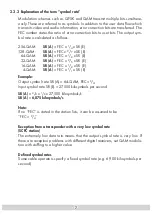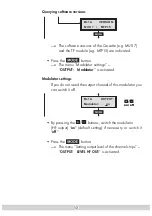
- 5 -
- 5 -
2.3 Description
The Cassettes convert two COFDM modulated signals into one QAM-modulated
data flow. The Cassettes are controlled via the head end.
Each Cassette has two terrestrial inputs and one HF output.
Each Cassette is equipped with two channel strips (“A” and “B”). The channel strips
consist of the digital terrestrial tuners, the digital signal preparing units and the
output QAM converter. The Cassettes´ channel strips are indicated by “Bx…A” or
“Bx…B” in the control unit display.
The integrated TP module (Transport Stream Processing) processes the data
from the demodulated transport flow. In this way, service information can be
modified (NIT – Network Information Table), stations can be selected and data
rates can be increased (Stuffing). The TP module allows to create a new data
flow out of the stations selected individually from the two data flows.
The prepared input signals are transmitted to the HF output collector of the head
end via the HF output socket. The output level of the Cassettes can be set with the
level regulator (max. –20 dB) at the output collector of the head end.
The operating software of the Cassette can be actualised via the 9-pin SUB-D-
socket, using a PC or notebook and the software “
BE-Flash
”. You can find the
current operating software of the Cassettes on the website “
After the head end has been switched on, the software version of the control
unit is displayed briefly in the two-line LC display and afterwards the type of
Cassette of the first slot.
Approximately five minutes after the last button has been pressed, the software
version of the control unit is displayed.
The Cassettes are designed for use in the following head ends:
– STC
316
– STC
332
– STC
1200
– STR
19–8






































